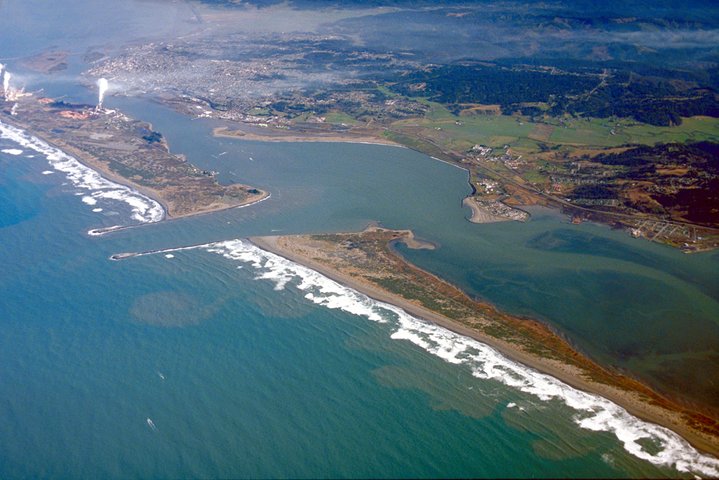
The north and south jetties and the entrance to the bay, with Tuluwat Island in the far background.Photo: US Army Corps of Engineers, via Wikimedia. GNU public license.
###
This is quite something.
Today, the Army Corps of Engineers announced that it and UC Berkeley have worked to repatriate the remains of 20 people who were discovered during the construction of the jetties in the 1950s.
According to a press release, some time ago the remains — which were in the custody of an anthropology museum on the campus of UC Berkeley — were determined to be those of Wiyot people. Then, last year, researchers determined that they were likely to have been killed during the Indian Island Massacre of 1860.
“We had a feeling that’s who they were,” Ted Hernandez, tribal historic preservation officer of the Wiyot Tribe, told the Outpost “because of some of the stories we’ve heard about how some of the individuals that were massacred were brought to that certain spot where they were at, and some were taken to certain other spots.”
We reached out to UC Berkeley to ask how it was the bodies were likely those of massacre victims, but Dr. Thomas Torma, the university’s liaison under the Native American Graves and Repatriation Act, would say only that the research was done at the request of the Wiyot Tribe and is “held in confidence with them.”
Hernandez said that the bodies, along with 136 objects of cultural significance, were returned to the tribe last month.
Press release from the U.S. Army Corps of Engineers:
The U.S. Army Corps of Engineers San Francisco District and the University of California, Berkeley, have successfully repatriated 20 human remains and 136 objects of historical, traditional and cultural importance to the Wiyot Tribe of Loleta, Calif.
The collection resided in the Phoebe A. Hearst Museum of Anthropology at UC Berkeley. The remains and associated items were uncovered in 1946 during construction activities related to the Humboldt Bay Jetties, which were built by the Corps. A cultural affiliation study conducted by Statistical Research Inc. for the Corps found the human remains were likely to be lineal descendants of the Wiyot people, based on ethnographic, linguistic, osteological and archaeological data. Further research conducted by UC Berkeley in 2021 indicated that these individuals were likely victims of the Indian Island Massacre, which took place on Feb. 26, 1860, when settlers attacked numerous Wiyot villages.
The Wiyot are Indigenous people of California who have lived in the Humboldt Bay region since time immemorial. Today, there are about 650 tribal members who enrolled in several federally recognized tribes, such as the Wiyot Tribe, Bear River Band of the Rohnerville Rancheria and Blue Lake Rancheria.
The U.S. Army Corps of Engineers San Francisco District and UC Berkeley first consulted with numerous tribes concerning the collection in September 2007. Information supplied by the Wiyot Tribe and other federally recognized tribes with Wiyot composition supported the research of the two agencies. The tribe recognized that the human remains belonged to the Wiyot and then requested the return of the remains and associated funerary items. The U.S. Army Corps of Engineers San Francisco District and UC Berkeley agreed to follow the process of repatriation pursuant to the Native American Graves Protection and Repatriation Act (NAGPRA).
NAGPRA is a federal law enacted by Congress in 1990 to ensure the return of Native American human remains, funerary objects, sacred objects and objects of cultural patrimony to lineal descendants, Indian tribes and Native Hawaiian organizations.
Ted Hernandez, Cultural Director and Tribal Historic Preservation Officer for the Wiyot Tribe, said, “We have been working to return the remains of our relations for years. We are thankful to finally be able to welcome them home.”
This repatriation is a benchmark for the U.S. Army Corps of Engineers and the University, since, at the time of the excavation, neither party could clearly determine who owned the land where the remains were discovered. As a result, it was unclear who should conduct the repatriation. Rather than delay the process for years, and at the request of the tribe, the two parties conducted the repatriation jointly.“This a tremendous day for us” said Hernandez. “It reflects the commitment of the University to find ways to make repatriation happen, to work constructively with our tribe, and agency partners.”
The Wiyot ancestral territory encompasses the area bounded by Little River to the north, Bear River Ridge to the south, the Pacific Coast to Berry Summit in the northeast, and Chalk Mountain in the southeast. The tribe’s current land holdings include 88 acres on the south end of Humboldt Bay, five miles from the town of Loleta, which is where its tribal government seat is located.
CLICK TO MANAGE